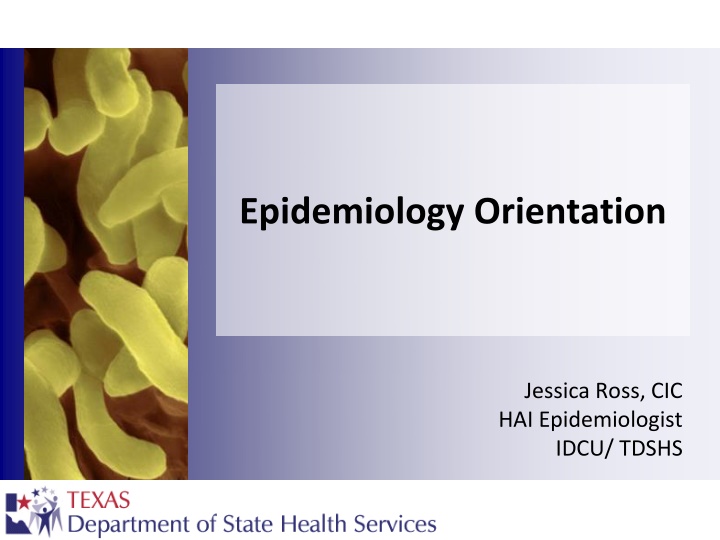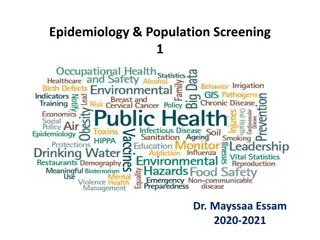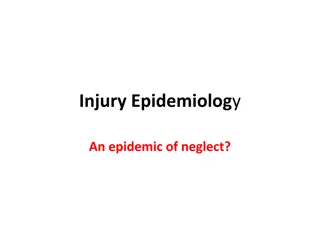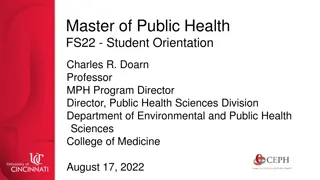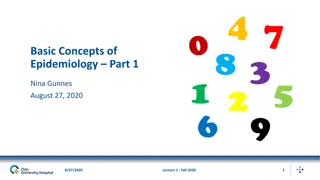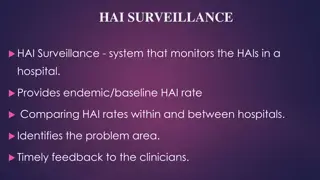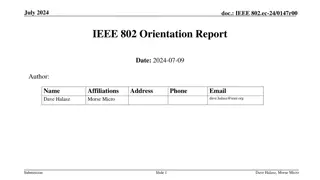Epidemiology Orientation with HAI Epidemiologist
This content delves into the role of an HAI Epidemiologist at the Texas Department of State Health Services, covering topics such as CRE/MDR-A transmission, individuals at risk, history of resistance, reporting requirements, case examples, laboratory control measures, infection prevention, and supplementary recommendations. It also touches on investigating a range of infectious diseases and situations, including bloodborne pathogens, meningitis, influenza, emergency preparedness, MRSA, CDIFF, CRE, MDR-Acinetobacter, high-consequence diseases, and more.
Download Presentation

Please find below an Image/Link to download the presentation.
The content on the website is provided AS IS for your information and personal use only. It may not be sold, licensed, or shared on other websites without obtaining consent from the author.If you encounter any issues during the download, it is possible that the publisher has removed the file from their server.
You are allowed to download the files provided on this website for personal or commercial use, subject to the condition that they are used lawfully. All files are the property of their respective owners.
The content on the website is provided AS IS for your information and personal use only. It may not be sold, licensed, or shared on other websites without obtaining consent from the author.
E N D
Presentation Transcript
Epidemiology Orientation Jessica Ross, CIC HAI Epidemiologist IDCU/ TDSHS Texas Department of State Health Services Home
Texas Department of State Health Services Home Objectives The HAI Epidemiologist What is CRE/ MDR-A Transmission Who is at risk History of Resistance Reporting requirements Case Examples Laboratory Control measures/ infection prevention Additional recommendations/ Supplemental measures
Texas Department of State Health Services Home HAI Epidemiologist Covers a multitude of Infectious Diseases and situations Bloodborne Pathogens Meningitis Influenza Emergency preparedness Multidrug-resistant organisms (MDROs) MRSA, CDIFF More emerging and urgent threats: CRE, MDR-Acinetobacter (MDR-A) High consequence diseases Measles Ebola or other VHF
Texas Department of State Health Services Home HAI Investigation Team Jessica Ross HSR 1 Thi Dang HSR 2/3 Interim, Thi Dang HSR 4/5 N Jessica Ross HSR 9/10 Sandi Henley HSR 7 Jessica Ross HSR 8 Bobbiejean Garcia HSR 6/5 S Interim, Bobbiejean Garcia HSR 11
Texas Department of State Health Services Home HAI Investigation Team Jessica Ross, CIC Central office Covers HSR 1, 9/10, and 8 Phone: 512-776-6356, cell: 512-956-1029 Bobbiejean Garcia, MPH, CIC HSR 6/5 S Regional HAI Epi Interim for HSR 11, pending job interviews Phone: 713-767-3404 Thi Dang, MPH, CIC HSR 2/3 Regional HAI Epi Interim for HSR 4/5 N, pending job interviews Phone: 817-264-4585 Sandi Henley, RN, CIC HSR 7 Regional HAI Epi Phone: 254-750-9387
Texas Department of State Health Services Home What is Enterobacteriaceae? Large family of gram-negative bacilli More than 70 species E. coli, Klebsiella, Enterobacter, Shigella, Salmonella Normal part of the GI tract Common cause of infections Community Healthcare associated
Texas Department of State Health Services Home What is Acinetobacter? Common in soil & water A. baumannii 80% of reported infections Can cause variety of illnesses Little risk to the healthy
Texas Department of State Health Services Home Transmission Person-to-person Contact with positive patients Contact with wounds or stool Medical devices or equipment Inanimate objects
Texas Department of State Health Services Home Who is at Risk? CRE & MDR-A infections are more common in patients who have: Frequent or prolonged hospital stays Prolonged antibiotic use Indwelling medical devices o Foley s o Central lines Chronic medical conditions o COPD, asthma o History of surgery o Decubitus
Texas Department of State Health Services Home Why are these Important? Complex resistance Rapid transmission in health-care settings Limited treatment options available High mortality rates
The Development of Resistance Texas Department of State Health Services Home Original treatment with beta-lactam antibiotics such as Penicillin s Created the production of -lactamases (enzymes) Resistance to penicillin's Then, production of Extended Spectrum -lactamases or ESBL s Resistance to -lactams, monobactams & 3rd gen ceph (known as extended spectrum antibiotics). 200 different kinds of ESBL s (enzymes) which do not effect 2nd gen ceph and carbapenems ESBL s are NOT a CRE Then, production of Carbapenemase Resistance to Carbapenems (class of beta-lactam antibiotics-last resort): Imipenem, meropenem, doripenem, ertapenem Identified pan-resistant strains
Texas Department of State Health Services Home Carbapenemases in the U.S. Klebsiella pneumoniae carbapenemase (KPC) Most often found in Klebsiella spp. & E. coli Metallo-beta-lactamases (MBL) New Delhi (NDM) Verona integron-encoded (VIM) Imipenemase (IMP) **All of these are enzymes that make a bacteria be labeled as CRE Klebsiella pneumoniae
Texas Department of State Health Services Home Resistance Mechanisms So how do these enzymes work? Mechanisms for Enterobacteriaceae to be a CRE Active efflux of antibiotic o System pumps out unwanted substances, like antibiotics Structural mutations with overproduction of -lactamases o Loss of proteins on the outer membrane and prevents antibiotic entry Production of carbapenemases
Texas Department of State Health Services Home Defining CRE CDC NHSN MDRO Protocol E.coli or any Klebsiella spp. testing RESISTANT to imipenem, meropenem, doripenem, or Ertapenem by standard susceptibility testing methods or by a positive result for any method FDA-approved for carbapenemase detection from specific specimen sources
Texas Department of State Health Services Home Defining MDR-Acinetobacter Nonsusceptible to at least 1 antibiotic in at least 3 antimicrobial classes of the following 6 antimicrobial classes: *note: only the below listed antibiotics can be used to meet this definition Aminoglycosides Carbapenems Fluoroquinolones Cephalosporins Sulbactam Beta-Lactam Piperacillin Piperacillin/ tazobactam Amikacin Gentamicin Tobramycin Imipenem Meropenem Doripenem Ciprofloxacin Levofloxacin Cefepime Ceftazidime Ampicillin/ sulbactam
Texas Department of State Health Services Home Case Examples
Texas Department of State Health Services Home Case 1 NOT Reportable Why??
Texas Department of State Health Services Home Case 2 What about the Pseudomonas? Reportable or Not?? Why??
Texas Department of State Health Services Home Case 3 Final report: Enterobacter cloacae NOT Reportable Why??
Texas Department of State Health Services Home Lab Detection for CRE Clinical and Laboratory Standards Institute (CLSI) breakpoints for determining carbapenem susceptibility Breakpoints were lowered to improve detection Modified Hodge Test (MHT) Tests for carbapenemase Not necessary with the recommended lowered breakpoints Other methods PCR- only for KPC or NDM
Texas Department of State Health Services Home Molecular Subtyping PFGE (Pulse Field Gel Electrophoresis) All positive K. pneumoniae isolates delivered to or tested at DSHS central lab are tested by PFGE for molecular subtyping (to build molecular database) Other isolates may be submitted for PFGE with the approval of an HAI Epidemiologist.
Texas Department of State Health Services Home When to Submit Contact your regional HAI Epidemiologist prior to submission of any isolates If isolates are sent without Epi approval (especially without antimicrobial susceptibility testing (AST)), lab will contact epi before sample is processed.
Texas Department of State Health Services Home How to Submit? Fill out G2B form Information on DSHS lab website on how to request submission forms http://www.dshs.state.tx.us/lab/
Texas Department of State Health Services Home Prevention Recommendations for: Acute and long-term acute care facilities Health departments Health-care providers Patients and the public
Texas Department of State Health Services Home Core Prevention Measures
Texas Department of State Health Services Home Hand Hygiene Cont
Core Prevention Measures cont Texas Department of State Health Services Home 2. Contact Precautions Any patient colonized or infected with CRE should be placed in precautions PPE (personal protective equipment) Hand hygiene before gowning and gloving Gown and gloves before entering patient s room Remove gown and gloves before leaving room, then perform hand hygiene Monitor adherence and provide feedback Discontinuation of precautions: currently no recommendations
Texas Department of State Health Services Home Contact Precautions Cont Long term acute care (LTAC) Use strict contact precautions when a patient is: Incontinent of stool Not cognitive or behaviorally intact, patient relies a lot on HCP Ventilator-dependent Have large draining wounds that cannot be contained Possible to relax precautions when a patient is: Continent of stool Cognitive and behaviorally intact No draining wounds
Core Prevention Measures cont Texas Department of State Health Services Home 3. Patient and staff cohorting Single-patient rooms if available If not available, cohort patients with like organisms Staff cohorting: when possible cohort CRE patients to specific areas and staff Try keeping CRE patients on specific units Try using dedicate staff for affected units or limit the number of staff
Control Prevention Measures cont.. Texas Department of State Health Services Home 4. Limit use of medical devices Indwelling medical devices increase a patients risk for infection Processes in place for manipulation of devices when in use Discontinue devices as soon as possible Should be monitored on a daily basis
Core Prevention Measures cont 5. Antimicrobial stewardship Texas Department of State Health Services Home Ensure appropriate use and duration of antibiotics Stewardship programs can help with: Antimicrobial resistance Additional cost A better system to help with discontinuation of antimicrobials
Core Prevention Measures cont Texas Department of State Health Services Home 6. CRE screening Helps to identify patients that might be colonized with CRE who can still spread CRE Recommended site for screening: stool, rectal, or peri-rectal cultures Point prevalence survey You have positive patients and want to look for additional positive patients Screening of epidemiologically linked patients A good prevention strategy Also used for outbreak situations
Texas Department of State Health Services Home Additional Measures Accurate lab detection and notification of CRE Retrospective surveillance Perform surveillance (6-12mos) to find unreported CRE Intra and inter-facility communication of patients
Texas Department of State Health Services Home Transfer Form
LTAC Specific Recommendations Resident placement Low vs. high risk Modified contact precautions Occupational and physical therapy Controlled vs. uncontrolled secretions/excretions Social activities Infection risk vs. psychological risk Admission of CRE+ patients is ok Texas Department of State Health Services Home
Texas Department of State Health Services Home Supplemental Measures 1. Active surveillance testing Reactive vs. Proactive approach It is up to a facility to decide which approach they prefer. Patients identified as positive on these surveillance cultures should be treated as colonized (i.e., contact precautions, etc.) 2. 2 % Chlorhexidine (CHG) bathing Different practices may occur when dealing with acute care settings vs. long term care settings
Texas Department of State Health Services Home References 1. Association of Professionals in Infection Control. (March, 2013). CRE: the nightmare bacteria . Retrieved from http://apic.org/For-Consumers/ip- topics/Article?id=cre-the-nightmare-bacteria Bilavsky, E., Schwaber, M. J., & Carmeli, Y. (2010). How to stem the tide of carbapenemase-producing Enterobacteriaceae? Current Opinion in Infectious Diseases, 23(4), 327-31. doi: 10.1097/QCO.0b013e32833b3571 Centers for Disease Control and Prevention (CDC). (2011). Carbapenem-resistant Klebsiella pneumonia associated with long-term-care facility-West Virginia, 2009-2011. MMWR, Morbidity and Mortality Weekly Report, 60(41), 1418-20. Centers for Disease Control and Prevention (CDC). (2012). Guidance for control of carbapenem-resistant Enterobacteriaceae, 2012 CRE toolkit. Centers for Disease Control and Prevention. (March, 2013). Making health care safer. Retrieved from http://www.cdc.gov/vitalsigns/hai/cre/ Centers for Disease Control and Prevention. (2010). Options for evaluating environmental cleaning. Retrieved from http://www.cdc.gov/HAI/toolkits/Appendices-Evaluating-Environ-Cleaning.html#fig1 Centers for Disease Control and Prevention (CDC). (2013). Vital signs: carbapenem-resistant Enterobacteriaceae. MMWR, Morbidity and Mortality Weekly Report, 62(9), 165-70. Gupta, N., Limbago, B. M., Patel, J. B., & Kallen, A. J. (2011). Carbapenem-resistant Enterobacteriaceae: epidemiology and prevention. Clinical Infectious Disease, 53(1), 60-7. doi: 10.1093/cid/cir202 Halstead, D. C., Sellen, T. J., Adams-Haduch, J. M., Dossenback, D. A., Abid, J., Doi, Y., & Paterson, D. L. (2009). Klebsiella pneumoniae Carbapenemase- producing Enterobacteriaceae, Northeast Florida. Southern Medical Journal, 102(7), 680-7. doi: 10.1097/SMJ.0b013e3181a93f9e 10. Lokan, L. (2012). Carbapenem-resistant Enterobacteriaceae: an emerging problem in children. Clinical Infectious Disease, 55(6), 852-9. doi: 10.1093/cid/cis543 11. Marchaim, D., Chopra, T., Pogue, J. M., Perez, F., Hujer, A. M., Rudin, S., Endimiani, A., Navon-Venezia, S., Hothi, J., Slim, J., Blunden, C., Shango, M., Lephart, P. R., Salimnia, H., Reid, D., Moshos, J., Hafeez, W., Bheemreddy, S., Chen, T. Y., Dhar, S., Bonomo, R. A., Kaye, K. S. (2011). Outbreak of colistin-resistant, carbapenem-resistant Klebsiella pneumonia in metropolitan Detroit, Michigan. Antimicrobial Agents and Chemotherapy, 55(2), 593-9. doi: 10.1128/AAC.01020-10 12. Minnesota Department of Health. (2012). Minnesota Department of Health Recommendations for the Management of Carbapenem-resistant Enterobacteriaceae in Long-Term Care Facilities. Retrieved from http://www.health.state.mn.us/divs/idepc/dtopics/cre/rec.pdf 13. Perez, F., & Van Duin, D. (2013). Carbapenem-resistant Enterobacteriaceae: a menace to our most vulnerable patients. Cleveland Clinic Journal of Medicine, 80(4), 225-33. doi: 10.3949/ccjm.80a.12182 14. Schwaber, M. J. & Carmeli, Y. (2008). Carbapenem-resistant Enterobacteriaceae: a potential threat. The Journal of the American Medical Association, 300(24), 2911-3. doi: 10.1001/jama.2008.896 15. Wu, D., Cai, J., & Liu, J. (2011). Risk factors the acquisition of nosocomial infection with carbapenem-resistant Klebsiella pneumonia. Southern Medical Journal, 104(2), 106-10. doi: 10.1097/SMJ.0b013e318206063d 2. 3. 4. 5. 6. 7. 8. 9.
